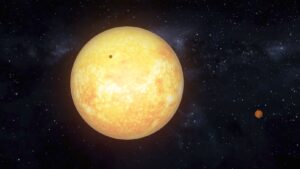Astronomers in Toruń have discovered a super-Earth almost twice the size and fifteen times the mass of Earth. It orbits its star in just 35 hours in a very tight orbit, which means that the planet’s surface temperature exceeds one thousand degrees Celsius. The planet, identified around the star WASP-84, is expected to have no atmosphere due to the high temperature. Astronomers from Toruń carried out this groundbreaking research, revealing unexpected planetary companions in a hot Jupiter system.

Photo: https://portal.umk.pl/
– For a long time, these types of planets were thought to be loners devoid of massive planetary companions, which in turn directly influenced our ideas about the formation and evolution of planetary systems – explains dr habil. Gracjan Maciejewski, NCU Prof., leader of the research group from the Institute of Astronomy at the Faculty of Physics, Astronomy and Computer Science. – However, this picture has changed over the last few years, as additional planets have started to be discovered in single planetary systems with hot Jupiters. We decided to contribute to this small revolution.
The WASP-84 planetary system was one of ten that Weronika Łoboda studied as part of her thesis (Bachelor of Science). She found a weak and barely noticeable signal in the noise from the star WASP-84. Her calculations indicated that the decreases in brightness were only half a thousandth of the recorded light flux.
– It must have been a really small planet and, in addition, located 16 times closer to its star than Mercury in the Solar System! – point up Weronika Łoboda.
Some of the research was conducted by mgr Jan Golonka, a doctoral student from the Interdisciplinary Doctoral School “Academia Copernicana”.
– After several days of intensive analyses, we became certain that this faint signal came from a new planet. Moreover, using archival observations, we were able to determine its mass – says mgr Golonka. – This allowed us to sketch a model of the planet’s internal structure, which turned out to be a scaled-up Earth with an iron-rich core and a silicate mantle.
Even though thousands of planets in hundreds of extrasolar planetary systems are now known, WASP-84 is only the sixth system to contain a hot Jupiter and an additional low-mass planet and the third with the mass of such a planet determined. Astronomers believe that there will be more discoveries of this discoveries of this type will become more common as detection techniques improve.
The Toruń astronomers’ discovery was presented during the jubilee Congress of the Polish Astronomical Society, held 11-15 September in Toruń. It was also published in the October issue of “Monthly Notices of the Royal Astronomical Society: Letters”. The article is available here, its publicly available preprint can also be found here. The article is the result of an international collaboration with the researchers from Germany and Spain.
Link to article:
https://academic.oup.com/mnrasl/article-abstract/525/1/L43/7199781?login=false
https://arxiv.org/pdf/2305.09177.pdf
Link to website:
https://portal.umk.pl/en/article/hot-super-earth-discovered


